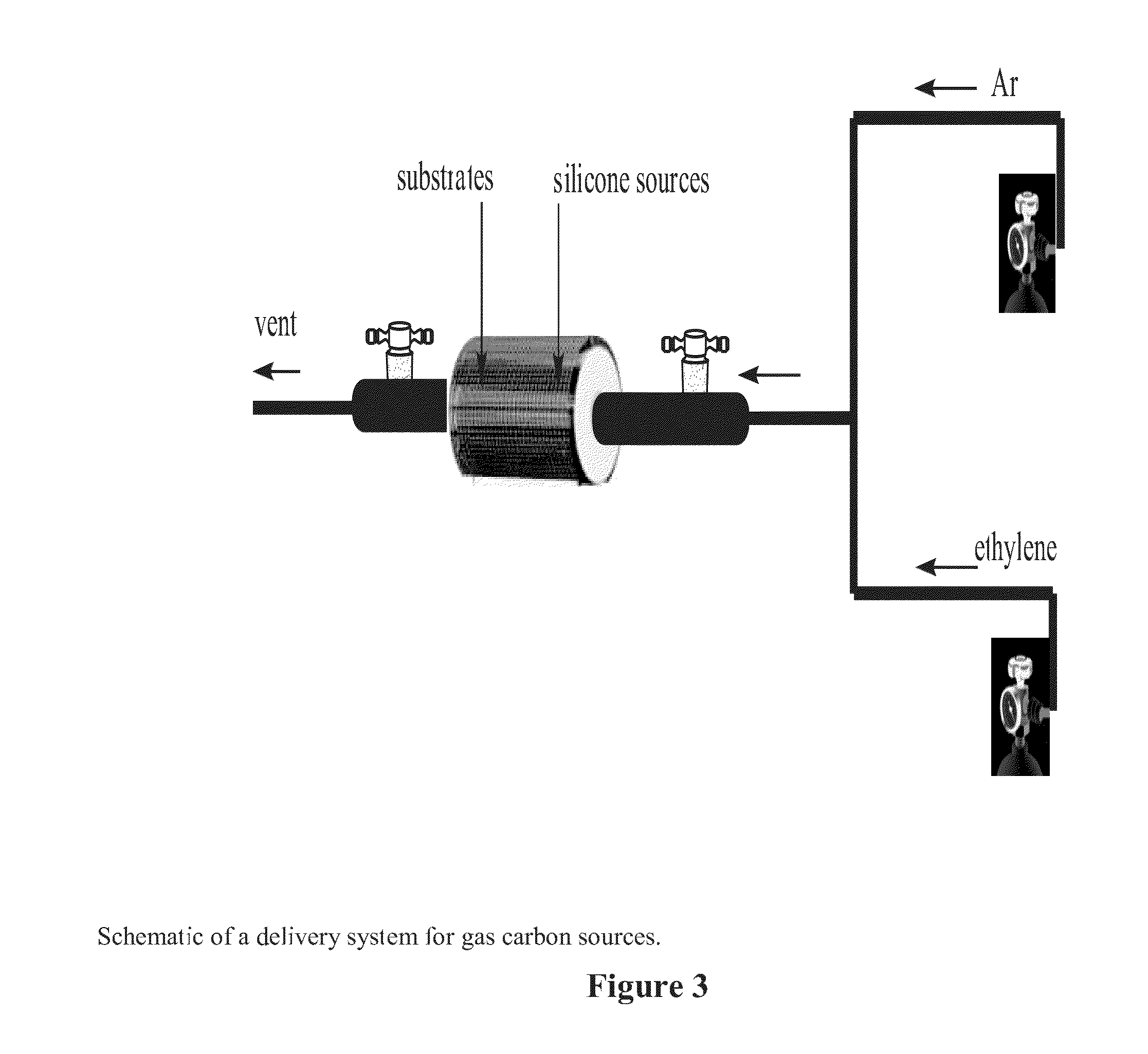Graphene-like nanosheet structure network on a substrate and the method for forming the same
a graphene-like nanosheet and structure network technology, applied in silicon compounds, oxy/sulfo carbides, carbides, etc., can solve the problems of reducing the graphene properties, unable to withstand high temperatures, and not being able to access ceramics, glass, metals and semi-conductor materials,
- Summary
- Abstract
- Description
- Claims
- Application Information
AI Technical Summary
Benefits of technology
Problems solved by technology
Method used
Image
Examples
example 1
Silicon Carbide (and / or Silicon Oxycarbide) Bonded Graphene-Like Network Coated on Quartz Plates Using CVD of a Solid Carbon Source and a Silicone Source
[0077]A solid carbon source, naphthalene (purchased from Aldrich, USA) with a purity of 99%, was used for the purpose of graphene formation and surface coating. Two 1 / 16″ thick quartz plates with 1″×1″ dimension and a piece of silicon-containing polymer or cyano-containing polymer with a weight of 1 gm were pre-placed inside the 2″ quartz tube of a furnaceinside the heating zone. 2 gm of naphthalene was also placed in the quartz tube, but outside the heating zone and near the gas inlet. An inert gas, Argon was applied to purge air inside the quartz tube with a flow rate of 300 SCCM for 10 minutes and then the flow rate was decreased to 200 SCCM. The temperature was quickly increased from room temperature to 750° C. under the inert gas atmosphere in the high temperature furnace and then the quartz tube outside the heating zone with t...
example 2
Silicon Carbide (and / or Silicon Oxycarbide) Bonded Graphene Network Coated on Silicon Wafers Using CVD of a Solid Carbon Source and a Silicon Source
[0082]Similar to Example 1, two pieces of 2″ diameter silicon wafers and 1 grams of silicon-containing polymer were placed in the quartz tube inside the heating zone of the high temperature furnace. 2 grams of naphthalene were also placed outside the heating zone in the quartz tube with Ar gas atmosphere at a flow rate same as in Example 1. A similar thermal cycle was applied for coating and then the silicon wafers were from the quartz tube. FIG. 7 shows a Si wafer and a graphene-like network coated Si wafer.
example 3
Silicon Carbide (and / or Silicon Oxycarbide) Bonded Graphene-Like Network Coated on Quartz Plates Using CVD of Liquid Carbon Source and Liquid Silicon Source
[0083]A liquid carbon source, benzene anhydrous (purchased from Aldrich, USA) with a purity of 99.8% in glass bubbler and a liquid silicon source, TMOS (Tetramethylorthosilicate, purchased from Aldrich, USA, 99.9%) in another glass bubbler were used for the purpose of graphene-like network and / or silicon carbide / oxycarbide bonded graphene-like network formation and surface coating. Two 1 / 16″ thick quartz plates with 1″×3″ dimension were pre-placed inside the 2″ quartz tube of a furnace inside the heating zone. An inert gas, Argon was applied to purge air inside the quartz tube with a flow rate of 300 SCCM for 10 minutes and then the flow rate was decreased to 200 SCCM. The temperature was increased from room temperature to 950° C. (at 20° C. / min) under the inert gas atmosphere. After the pre-specified temperature was reached, ben...
PUM
| Property | Measurement | Unit |
|---|---|---|
| Temperature | aaaaa | aaaaa |
| Temperature | aaaaa | aaaaa |
| Structure | aaaaa | aaaaa |
Abstract
Description
Claims
Application Information
 Login to View More
Login to View More - R&D
- Intellectual Property
- Life Sciences
- Materials
- Tech Scout
- Unparalleled Data Quality
- Higher Quality Content
- 60% Fewer Hallucinations
Browse by: Latest US Patents, China's latest patents, Technical Efficacy Thesaurus, Application Domain, Technology Topic, Popular Technical Reports.
© 2025 PatSnap. All rights reserved.Legal|Privacy policy|Modern Slavery Act Transparency Statement|Sitemap|About US| Contact US: help@patsnap.com



